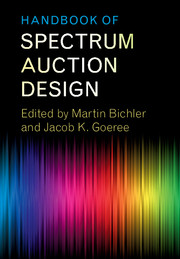Book contents
- Frontmatter
- Contents
- List of Contributors
- Preface
- List of Papers
- Part I The Simultaneous Multiple-Round Auction
- Part II The Combinatorial Clock Auction Designs
- Part III Alternative Auction Designs
- Part IV Experimental Comparisons of Auction Designs
- Part V The Bidders’ Perspective
- Part VI Secondary Markets and Exchanges
- 36 Spectrum Markets: Motivation, Challenges, and Implications
- 37 Designing the US Incentive Auction
- 38 Solving the Station Repacking Problem
- 39 ICE: An Expressive Iterative Combinatorial Exchange
- 40 ACE: A Combinatorial Market Mechanism
- Outlook
- References
39 - ICE: An Expressive Iterative Combinatorial Exchange
from Part VI - Secondary Markets and Exchanges
Published online by Cambridge University Press: 26 October 2017
- Frontmatter
- Contents
- List of Contributors
- Preface
- List of Papers
- Part I The Simultaneous Multiple-Round Auction
- Part II The Combinatorial Clock Auction Designs
- Part III Alternative Auction Designs
- Part IV Experimental Comparisons of Auction Designs
- Part V The Bidders’ Perspective
- Part VI Secondary Markets and Exchanges
- 36 Spectrum Markets: Motivation, Challenges, and Implications
- 37 Designing the US Incentive Auction
- 38 Solving the Station Repacking Problem
- 39 ICE: An Expressive Iterative Combinatorial Exchange
- 40 ACE: A Combinatorial Market Mechanism
- Outlook
- References
Summary
Introduction
Combinatorial exchanges combine and generalize two different mechanisms: double auctions and combinatorial auctions. In a double auction (DA), multiple buyers and sellers trade units of an identical good (McAfee, 1992). In a combinatorial auction (CA), a single seller has multiple heterogeneous items up for sale (de Vries & Vohra, 2003; Cramton, Shoham, & Steinberg, 2006). Buyer valuations can exhibit complements (“I want A and B”) and substitutes (“I want A or B”) properties. CAs provide an expressive bidding language to describe buyer valuations. A common design goal in DAs and CAs is to implement the efficient allocation, which is the allocation that maximizes social welfare, i.e. the total value.
A combinatorial exchange (CE) (Parkes, Kalagnanam, & Eso, 2001) is a combinatorial double auction and allows multiple buyers and sellers to trade on multiple, heterogeneous goods. A motivating application is to the reallocation of U.S. wireless spectrum from low-volume television stations to digital cell phone services (Cramton, Kwerel, & Williams, 1998; Cramton, Lopez, Malec, & Sujarittanonta, 2015). An incentive auction has been proposed for this application. This auction design uses a reverse auction to buy back existing spectrum rights followed by a forward auction to sell these rights to new owners. (See “Designing the US Incentive Auction” by Mulgrom and Segal.) One advantage of the incentive auction design is that it enables the use of existing CA technology for both the forward and reverse stages. In addition, the proposed design uses optimization to solve the complex repacking problem of shifting incumbent users’ allocation to new bands, which can free up a significant amount of bandwidth (Frechette, Newman, & Leyton-Brown, 2015).
CEs present an alternative design where both demand-side and supply-side price discovery happen in tandem, leading to coordinated information revelation and potential efficiency gains. The separation between stages in an incentive auction opens the possibility of the government purchasing either too little or too much spectrum in the reverse stage for subsequent sale in the forward stage. CEs avoid this problem by enabling the simultaneous purchase and sale of bandwidth by incumbents and new entrants alike. The (approximate) clearing prices obtained in CEs also provide meaningful value estimates for various spectrum combinations. These prices are useful in guiding demand and supply revelation (or preference elicitation, in the language of computer science).
- Type
- Chapter
- Information
- Handbook of Spectrum Auction Design , pp. 828 - 873Publisher: Cambridge University PressPrint publication year: 2017

